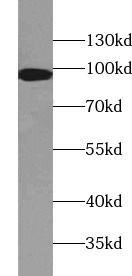Products
PDCD6IP antibody
Category:
Research Area:
| Synonyms: | AIP1 antibody, ALG 2 interacting protein 1 antibody, Alix antibody, DRIP4 antibody, HP95 antibody, KIAA1375 antibody, PDCD6 interacting protein antibody, PDCD6IP antibody | ||
| Catalogue No.: | FNab06243 | Reactivity: | Human, Mouse, Rat |
| Host: | Rabbit | Tested Application: | ELISA, WB, IHC |
| Clonality: | polyclonal | Isotype: | IgG |
- SPECIFICATIONS
- Product Name
- PDCD6IP antibody
- Catalogue No.
- FNab06243
- Size
- 100μg
- Form
- liquid
- Purification
- Immunogen affinity purified
- Purity
- ≥95% as determined by SDS-PAGE
- Clonality
- polyclonal
- Isotype
- IgG
- Storage
- PBS with 0.02% sodium azide and 50% glycerol pH 7.3, -20℃ for 12 months (Avoid repeated freeze / thaw cycles.)
Immunogen
- Immunogen
- programmed cell death 6 interacting protein
- Alternative Names
- AIP1 antibody, ALG 2 interacting protein 1 antibody, Alix antibody, DRIP4 antibody, HP95 antibody, KIAA1375 antibody, PDCD6 interacting protein antibody, PDCD6IP antibody
- UniProt ID
- Q8WUM4
- Observed MW
- 100 kDa
Application
- Tested Applications
- ELISA, WB, IHC
- Recommended dilution
- WB: 1:500 - 1:2000; IHC: 1:50 - 1:200
Validated Images
 Jurkat cells were subjected to SDS PAGE followed by western blot with FNab06243( PDCD6IP antibody) at dilution of 1:1000
Jurkat cells were subjected to SDS PAGE followed by western blot with FNab06243( PDCD6IP antibody) at dilution of 1:1000
 Immunohistochemistry of paraffin-embedded rat kidney using FNab06243( PDCD6IP antibody) at dilution of 1:100
Immunohistochemistry of paraffin-embedded rat kidney using FNab06243( PDCD6IP antibody) at dilution of 1:100
- Background
- This gene encodes a protein that functions within the ESCRT pathway in the abscission stage of cytokinesis, in intralumenal endosomal vesicle formation, and in enveloped virus budding. Studies using mouse cells have shown that overexpression of this protein can block apoptosis. In addition, the product of this gene binds to the product of the PDCD6 gene, a protein required for apoptosis, in a calcium-dependent manner. This gene product also binds to endophilins, proteins that regulate membrane shape during endocytosis. Overexpression of this gene product and endophilins results in cytoplasmic vacuolization, which may be partly responsible for the protection against cell death. Several alternatively spliced transcript variants encoding different isoforms have been found for this gene. Related pseudogenes have been identified on chromosome 15.



